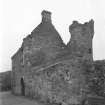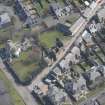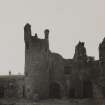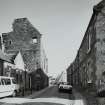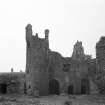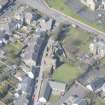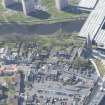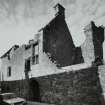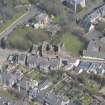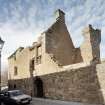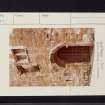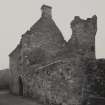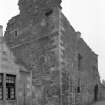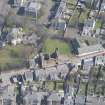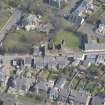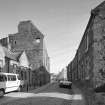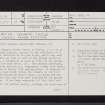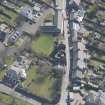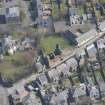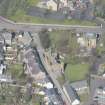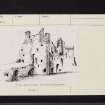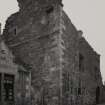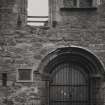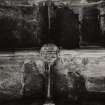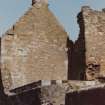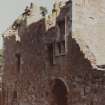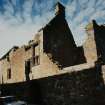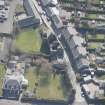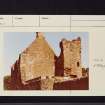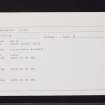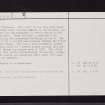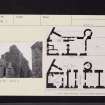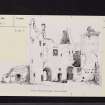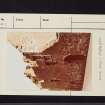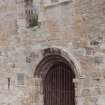Pricing Change
New pricing for orders of material from this site will come into place shortly. Charges for supply of digital images, digitisation on demand, prints and licensing will be altered.
Irvine, Seagate, Seagate Castle
Castle (Medieval), Motte (Medieval)(Possible)
Site Name Irvine, Seagate, Seagate Castle
Classification Castle (Medieval), Motte (Medieval)(Possible)
Alternative Name(s) 'Irewin'
Canmore ID 41935
Site Number NS33NW 3
NGR NS 31919 39149
Datum OSGB36 - NGR
Permalink http://canmore.org.uk/site/41935
- Council North Ayrshire
- Parish Irvine
- Former Region Strathclyde
- Former District Cunninghame
- Former County Ayrshire
NS33NW 3 3192 3915
(NS 3192 3915) Seagate Castle (NR) (Remains of)
OS 1:1250 map (1956)
For trial excavation at NS 3197 3916, see NS33NW 50.
Although Seagate Castle stands in Irvine, it is in no sense a town lodging, having all the attributes of a castle or fortalice in its own right, and it may well incorporate all that is left of the strong castle of 'Irewin', a stronghold of note in 1184, in the shadow of which the town arose (N Tranter 1965). The present structure, now roofless and ruinous, represents a very fine fortified house of mainly 16th century date. It consists of a lengthy main block facing the street, to the E of which have projected three towers, two round and one triangular; this may have been dictated by the ground formation. It has been suggested
(W Galloway) that this last is part of the earlier castle, although the walls are of no great thickness. The S half of the long main block and one round tower are now reduced to the basement and foundations but the remainder is fairly entire as far as the wallhead. There has been a courtyard with curtain walling and subsidiary building to the E. The entrance is by a vaulted pend running through the N half of the main block. This has a fine ornamental arched doorway near which is a modern plaque stating that the treaty of Irvine was signed here in 1297. This would depend on this castle incorporating the earlier stronghold. The castle was inhabited until about 1746 when its roof was removed.
D MacGibbon and T Ross 1892; G W S Barrow 1980
Seagate Castle is as described.
Visited by OS (JLD) 26 May 1954
No change. The castle and courtyard are closed to the public.
Revised at 1:2500.
Visited by OS (JRL) 9 June 1982
A trial excavation was carried out in October 1992. It revealed medieval deposits to a depth of 2.8m, where natural was encountered. The only structure was a short length of wall no dating evidence. Intermittent layers of clean blown sand were found, sealing that various deposits.
Sponsor: Irvine Development Corporation.
A Bailey 1992
NS 3192 3915 In February and March 2000 a watching brief was carried out during the removal of damaged concrete screed above the barrel vaults at the late 16th-century Seagate Castle (NMRS NS33NW 3), the oldest surviving structure in Irvine. The corbelled stonework of the upper roof of the vault was exposed, partly overlain by post-medieval to modern deposits of levelling material, and these were recorded before a waterproof membrane and new concrete screed were laid.
A drainage trench through the adjacent mound proved to be composed of modern dumped material, while a pit dug for a silt trap in the SE corner of the castle grounds established the presence of medieval and post-medieval cultivated soils up to 1.2m deep. Pottery dating from the 15th century was recovered from the earlier cultivated soils. (GUARD 841).
Sponsor: North Ayrshire Council.
O Lelong 2000.
Publication Account (1980)
Benedict of Peterborough, writing of June 1184, mentions a castle of Hirun which McJannet took to mean Irvine (1938, 91). Today at Irvine there are the ruins of a late sixteenth century fortified townhouse, the so-called Seagate Castle. 'The Seagate Castle', in the words of the editor of the burgh muniments, 'is the only remnant of the ancient civil and ecclesiastical buildings in the burgh which has survived the march of so-called modern improvement, all the others having been entirely cleared away' (Dobie, 1890, xxxii). Little is known of the history of Seagate Castle although it certainly belonged to the Earl of Eglintoun - the arms of the third earl, who died in 1585, have been embedded in the structure (MacGibbon and Ross, 1892, v, 240). Pococke in 1760 described the structure as ruinous (Kemp, 1887, 57) and it is not clear when the castle was abandoned. The walls of the northern portion are in fairly good condition as is the ground storey of the south end of the building, the gables and chimneys. It could possibly be on the site of an earlier work, but there is no evidence for this (Ordnance Survey, Record Cards, Reference NS 33 NW 3).
Information from ‘Historic Irvine: The Archaeological Implications of Development’ (1980).
Excavation (October 1992)
A trial excavation was carried out in October 1992. It revealed medieval deposits to a depth of 2.8m, where natural was encountered. The only structure was a short length of wall no dating evidence. Intermittent layers of clean blown sand were found, sealing that various deposits.
Sponsor: Irvine Development Corporation.
A Bailey 1992
Watching Brief (7 March 2012 - 11 April 2012)
NS 319 391 A watching brief was undertaken 7 March – 11 April 2012 during repair and conservation of the building fabric of Seagate Castle and removal of vegetation. The stump removal works indicated that all the trees had been rooted in a mid-brown silty deposit. A single test pit excavated in the SE corner of Chamber A established that the silty deposit was 300mm deep and that it overlay a 100mm deep mortar-like deposit. The mortar-like deposit lay directly above the vaulted ceiling of the underlying pend. A single sherd of late 15th- to 16th-century medieval green glaze pottery was located adjacent to a small flight of stone steps uncovered in Chamber B.
Archive: RCAHMS. Report: Historic Scotland and WoSAS
Funder: Robert Potter and Partners LLP on behalf of North Ayrshire Council
Rebecca Shaw, Rebecca Shaw Archaeological Services
2012
Project (18 August 2021)
NS 31930 39157 A geophysical survey was undertaken at Seagate Castle, Irvine on 18 August 2021. This survey forms part of wider evaluation of the site prior to consolidation works. The survey entailed resistance survey (0.8ha at 0.5m x 0.5m) and a Ground Penetrating Radar utilising a 500MHz antenna (0.8ha at 0.5m interval traverses) and a 250MHz antenna (0.8ha at 1m traverse interval).
The resistance survey has detected a wide variety of values across the site. In the SW of the survey area, adjacent to the extant castle, very low resistance has been recorded which is likely to be associated with increased moisture content of this ground. No anomalies suggesting the foundations of the known North range, or the cesspit have been detected. Well-defined anomalies have been detected in the N. While they appear structural in nature, given that resistance is usually only detecting to a depth of about 0.75m–1m, a modern origin associated with landscaping seems probable. A broad area of high resistance may suggest possible demolition rubble associated with a possible wing or wall related to the southern limits of the extant Castle although interpretation is tentative. More discrete, but ephemeral high resistance responses have also been noted in this area which may indicate remnants of surviving structural remains, although such an interpretation is cautious.
The 500MHz GPR survey has detected high amplitude
responses at a depth of 0.75m, which show good correlation with the resistance data supporting the presence of possible structures or demolition rubble associated with the southern limits of the castle. However, there is some suggestion in the GPR data that this may simply be associated with modern landscaping. Responses associated with the known western building and cesspit have been detected. Below 1m, there is some evidence in the GPR data for potential structural remains that may suggest features associated with earlier phases of the castle. However, responses from modern paths and past excavation introduces an element of caution.
The 250MHz GPR survey has identified potential earlier ground surfaces associated with the castle, prior to the area being landscaped in more recent times.
Archive: Rose Geophysical Consultants Funder: Rathmell Archaeology
Susan Ovenden – Rose Geophysical Consultants
(Source: DES Vol 22)
Ground Penetrating Radar (18 August 2021)
NS 31930 39157 Ground penetrating radar survey.
Archive: Rose Geophysical Consultants Funder: Rathmell Archaeology
Susan Ovenden – Rose Geophysical Consultants
(Source: DES Vol 22)
Earth Resistance Survey (18 August 2021)
NS 31930 39157 Resistivity survey.
Archive: Rose Geophysical Consultants Funder: Rathmell Archaeology
Susan Ovenden – Rose Geophysical Consultants
(Source: DES Vol 22)
















































